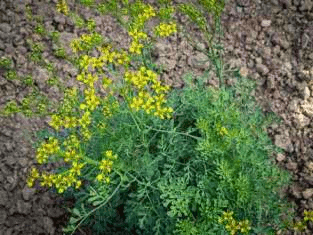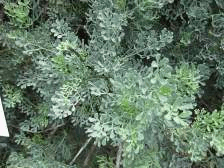Rue
Common Names: Rue, common rue, herb-of-grace
Scientific Name: Ruta graveolens
Climate: Warm and temperate
Plant description: It is a shrub that grows between 70-100 cm in height, with smooth, erect, little branched, hard stems. It has alternate bluish-green leaves with obovate, deeply lobed eyelets. The yellow flowers are grouped in clusters whose central flower has five petals and the rest of them only four; these petals appear slightly jagged on their edges; its fruit is a rounded capsule that contains several black seeds. The capsule develops on each flower while other flowers around it are still blooming. Foliage has a pungent aroma when crushed and the leaves have a bitter taste.
Its origin is Balkan Peninsula in Europe.
Cultivation: It grows in direct sun or in semi-shade. It prefers dry, stony, calcareous and well-drained soils. It does not tolerate compact soils that retain moisture. But it can adapt to poor soils as long as they are well drained. Once established, it endures drought. It thrives well in hot, dry places. Withstands low temperatures down to -15 ° C if protected from frost and wind.
It reproduces by seeds or cuttings. It is preferable to sow or plant it in spring or summer. To do so - prepare the pot by filling it with organic fertilizer. Make sure the compost is moist but not wet. Sow the seeds to a depth of 1.5 mm without covering them with the soil as the seeds need sun to germinate. Germination can take up to 3 weeks. When the seedlings reach the height of 7-10 cm, they are transplanted to their final place. They must be sown with a distance of 30 cm., Irrigation should be frequent but moderate. Once established, the rue is easily self-sowing.
It can also be propagated by cuttings by cutting the tips of the branches and rooting them in moist soil.
The rue needs a formation pruning in the middle of the spring or after the flowering and a complete pruning in the winter to strengthen the plant and the sprouts to be born. Wear long sleeves and gloves when pruning or handling foliage that can be toxic.
To harvest - rue leaves are collected before flowering, when the flower buds have already formed, but the flowers have not yet opened. At that time, the plant is richer in essential oils. Once the leaves are harvested, let them dry in a cool place and then store them in dry, clean containers in the shade.
Uses: It is found in Italian and Ethiopian food. It goes well with acidic flavors and is added to pickles. It also flavors meat, cheese, or eggs and tastes good with olives and capers in sauces.
 The leaves are used for colic, headache, dewormer and stimulates menstrual flow. It is used to decrease inflammation of the eyes or other eye problems.
The leaves are used for colic, headache, dewormer and stimulates menstrual flow. It is used to decrease inflammation of the eyes or other eye problems.
The extract and essential oil obtained from this plant species have been shown to possess various pharmacological activities including contraceptive, anti-inflammatory, antimicrobial, antipyretic (reduces fever), antioxidant, analgesic, anti-hyperglycemic, free radical uptake, hypotensive, antiviral, and anti-plasmodial.
Rue is an effective flea and mosquito repellent and is an excellent companion plant for strawberries, figs, roses, and raspberries, in part because it tends to help deter Japanese beetles.
All parts of this plant are poisonous in large quantities and should not be used by pregnant women at all, as they can induce abortions.
Pests and Diseases: Due to its strong smell, it keeps pests away, but it is affected by white flies and mites, especially when there is a lack of irrigation.
Root rot can occur, particularly in poorly drained soils.
References:
https://ecohortum.com/como-cultivar-ruda/
Transgenesis and Secondary Metabolism pp 1-28, Editors Sumita Jha, Ruta graveolens: Phytochemistry, Pharmacology, and Biotechnology, Authors Sonia Malik, Denise Fernandes Coutinho Moraes, Flavia Maria Mendonça do Amaral, Maria Nilce Sousa Ribeiro, 20 September 2016
En español: Ruda
